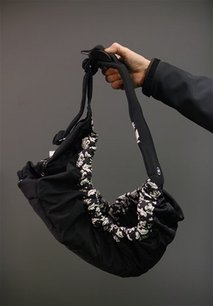 The government warned Friday that those chic baby slings that hip moms and dads are sporting these days can be dangerous, even deadly for their little ones.
The government warned Friday that those chic baby slings that hip moms and dads are sporting these days can be dangerous, even deadly for their little ones.
The Consumer Product Safety Commission said it has investigated at least 13 deaths associated with sling-style infant carriers over the last 20 years, including three deaths last year. One other case involving a fatality is still being investigated. Twelve of the deaths involved babies younger than four months of age, the agency said.
The commission is advising parents and caregivers to be cautious when using infant slings for babies younger than four months. It said that many of the babies who died in slings were a low birth weight twin, were born prematurely, or had a cold.
In its warning, CPSC said that slings can pose a suffocation hazard in two different ways.
_A sling’s fabric can press against a baby’s nose and mouth, blocking the baby’s breathing and suffocating a baby within a minute or two, the agency said.
_The other scenario involves slings where the baby is cradled in a curved or “C-like” position, nestling the baby below mom’s chest or near her belly. That curved position can cause a baby who doesn’t have strong neck control to flop its head forward, chin-to-chest, restricting the infant’s ability to breathe. “The baby will not be able to cry for help and can slowly suffocate,” said the commission’s warning.
The CPSC specializes in product safety, and often negotiates agreements with manufacturers for recalls, when necessary. It’s a part of the executive branch’s regulatory arm, charged with watching over its area of concentration in much the same way as similar agencies like the Food and Drug Administration and the Agriculture Department’s Food and Inspection Service.
Slings are made of soft fabrics that wrap around the chest so that on-the-go parents can carry their babies or just stay close as they bond with their infants. They have become increasingly popular in recent years with parents who want to “wear” their babies, known as “baby wearing”.
Slings also have been promoted by baby experts as a way to calm fussy babies or for nursing moms who can breast-feed their little ones in the sling.
In 2008, Consumer Reports raised concerns about slings and some two dozen serious injuries, such as skull fractures — mostly when a child fell out of the carrier.
Later, after the death last year of a 1-week-old Derrik Fowler in Oregon, safety advocates again warned about the slings and a suffocation risk. The baby died in a sling of positional asphyxia or suffocation, according to court records.
Safety advocates have been particularly worried about so-called “bag style” slings, in which the fabric wraps around the parent’s neck and cradles the child in a curved position, such as the sling used by Fowler’s parents.
But not all slings are dangerous, said Pat Shelly, director of The Breastfeeding Center for Greater Washington.
“The safest baby wearing is in a carrier that keeps the newborn baby solidly against his mother’s body, in an upright position,” Shelly said in an AP interview. “Parents should be instructed to allow the infant to keep his chin off his chest optimizing the airway for breathing.”
Shelly, a nurse, teaches classes at her center on how to properly wear a sling.
 The popular “SlingRider” by Infantino has been singled out for criticism because of the curved position that the baby can fall into while inside the sling. According to court documents, little Derrik Fowler was in an Infantino sling when he died and his parents are suing the company.
The popular “SlingRider” by Infantino has been singled out for criticism because of the curved position that the baby can fall into while inside the sling. According to court documents, little Derrik Fowler was in an Infantino sling when he died and his parents are suing the company.
Infantino says its SlingRider is safe. It also said in a statement that the company is working with the Consumer Product Safety Commission to address its concerns.
The SlingRider was recalled in 2007 for problems with the plastic sliders on the sling’s strap. There have been no recalls because of a suffocation risk.
The commission’s caution on slings came three days after its chairman, Inez Tenenbaum, told a meeting of the Juvenile Products Manufacturers Association that it planned to issue a warning to parents about the carriers.
JPMA, an industry trade group, certifies 20 children’s products, but does not have a certification program for slings. It is currently working with ASTM International, an organization that sets voluntary safety standards, to develop a standard for slings.
The Consumer Product Safety Commission also has no rules governing slings and potential dangers.
